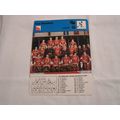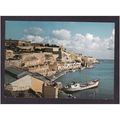Ship - SS United States, 1952 worlds fastest liner - art postcard c.1980s
- Condition : Used
- Dispatch : 2 Days
- Brand : None
- ID# : 182642003
- Quantity : 1 item
- Views : 215
- Location : United Kingdom

- Seller : justthebook (+1704)
- Barcode : None
- Start : Mon 17 Jun 2019 15:28:55 (BST)
- Close : Run Until Sold
- Remain : Run Until Sold
More Listings from This Seller view all
Seller's Description
- Postcard
- Picture / Image: SS United States, 1952 "World's Fastest Liner"
- Publisher: Magna Golden Age (Magna Books)
- Postally used: no
- Stamp: n/a
- Postmark(s): n/a
- Sent to: n/a
- Notes / condition:
Please ask if you need any other information and I will do the best I can to answer.
Image may be low res for illustrative purposes - if you need a higher definition image then please contact me and I may be able to send one. No cards have been trimmed (unless stated).
------------------------------------------------
Postage & Packing:
Postage and packing charge should be showing for your location (contact if not sure).
No additional charges for more than one postcard. You can buy as many postcards from me as you like and you will just pay the fee above once. Please wait for combined invoice. (If buying postcards with other things such as books, please contact or wait for invoice before paying).
Payment Methods:
UK - PayPal, Cheque (from UK bank) or postal order
Outside UK: PayPal ONLY (unless otherwise stated) please. NO non-UK currency checks or money orders (sorry).
NOTE: All postcards are sent in brand new stiffened envelopes which I have bought for the task. These are specially made to protect postcards and you may be able to re-use them. In addition there are other costs to sending so the above charge is not just for the stamp!
I will give a full refund if you are not fully satisfied with the postcard.
----------------------------------------------
Text from the free encyclopedia WIKIPEDIA may appear below to give a little background information (internal links may not work) :
*************
SS United States is a luxury passenger liner built in 1952 for United States Lines designed to capture the trans-Atlantic speed record.
Built at a cost of $79.4 million ($724 million in today's dollars)[1] the ship is the largest ocean liner constructed entirely in the U.S. and the fastest ocean liner to cross the Atlantic in either direction. Even in her retirement, she retains the Blue Riband, the accolade given to the passenger liner crossing the Atlantic Ocean in regular service with the highest speed.
Her construction was subsidized by the U.S. government, since she was designed to allow conversion to a troopship should the need arise.[10] United States operated uninterrupted in transatlantic passenger service until 1969. Since 1996 she has been docked at Pier 82 on the Delaware River in Philadelphia.
Inspired by the exemplary service of the British liners RMS Queen Mary and Queen Elizabeth, which transported hundreds of thousands of U.S. troops to Europe during World War II, the U.S. government sponsored the construction of a large and fast merchant vessel that would be capable of transporting large numbers of soldiers. Designed by renowned American naval architect and marine engineer William Francis Gibbs (1886–1967), the liner's construction was a joint effort between the United States Navy and United States Lines. The U.S. government underwrote $50 million of the $78 million construction cost, with the ship's operators, United States Lines, contributing the remaining $28 million. In exchange, the ship was designed to be easily converted in times of war to a troopship with a capacity of 15,000 troops, or to a hospital ship .[11]
The vessel was constructed from 1950–1952 at the Newport News Shipbuilding and Drydock Company in Newport News, Virginia. Her keel was laid and the hull constructed in a graving dock. United States was built to exacting Navy specifications, which required that the ship be heavily compartmentalized and have separate engine rooms to optimize wartime survival.[12] A large part of the construction of United States was with prefabricated sections. The ship's hull comprised 183,000 separately fabricated sections.[13]
To minimize the risk of fire, the designers of United States used no wood in the ship's framing, accessories, decorations, or interior surfaces. Fittings, including all furniture and fabrics, were custom made in glass, metal, and spun glass fiber to ensure compliance with fireproofing guidelines set by the U.S. Navy. Specially commissioned artwork included pieces by fourteen artists, including Nathaniel Choate, muralist Austin M. Purves, Jr., and sculptor Gwen Lux. Although the galley did feature a butcher block, the clothes hangers in the luxury cabins were aluminum. The ballroom's grand piano was of a rare, fire-resistant wood species—although originally specified in aluminum—and accepted only after a demonstration in which gasoline was poured upon the wood and ignited, without the wood itself igniting.[14]
The construction of the ship's superstructure involved the greatest use of aluminum in any construction project to that time, and posed a Galvanic corrosion challenge to the builders in joining the aluminum structure to the steel decks below. The extensive use of aluminum provided significant weight savings.[15]
United States had the most powerful steam turbines of any merchant marine vessel, with a total power of 240,000 shaft horsepower (180 MW) delivered to four 18-foot (5.5 m) diameter manganese-bronze propellers. This was the equivalent design of an Essex Class aircraft carrier and gave her the greatest power-to-weight ratio ever achieved in a commercial passenger liner, before or since. The ship was capable of steaming astern at over 20 knots (37 km/h; 23 mph), and could carry enough fuel and stores to steam non-stop for over 10,000 nautical miles (19,000 km; 12,000 mi) at a cruising speed of 35 knots (65 km/h; 40 mph).[16]
On her maiden voyage on July 3, 1952,[clarification needed] United States broke the transatlantic speed record held by RMS Queen Mary for the previous 14 years by over 10 hours, making the maiden crossing from the Ambrose lightship at New York Harbor to Bishop Rock off Cornwall, UK in 3 days, 10 hours, 40 minutes at an average speed of 35.59 knots (65.91 km/h; 40.96 mph). The liner also broke the westbound crossing record by returning to America in 3 days 12 hours and 12 minutes at an average speed of 34.51 knots (63.91 km/h; 39.71 mph), thereby obtaining both the eastbound and westbound speed records and the Blue Riband, the first time a US-flagged ship had held the speed record since SS Baltic claimed the prize 100 years earlier.
United States maintained a 30 knots (56 km/h; 35 mph) crossing speed on the North Atlantic in a service career that lasted 17 years.
United States lost the eastbound speed record in 1990 to Hoverspeed Great Britain; however, she continues to hold the Blue Riband as all subsequent record breakers were neither in passenger service nor were their voyages westbound.[17]
United States' maximum speed was deliberately exaggerated, and kept obscure for many years. An unlikely value of 43 knots (80 km/h; 49 mph) was leaked to reporters by engineers after the first speed trial.[18] A Philadelphia Inquirer article reported the top speed achieved as 36 knots (67 km/h; 41 mph),[19] while another source reports that the highest possible sustained top speed was 35 knots (65 km/h; 40 mph).[20]
Listing Information
| Listing Type | Gallery Listing |
| Listing ID# | 182642003 |
| Start Time | Mon 17 Jun 2019 15:28:55 (BST) |
| Close Time | Run Until Sold |
| Starting Bid | Fixed Price (no bidding) |
| Item Condition | Used |
| Bids | 0 |
| Views | 215 |
| Dispatch Time | 2 Days |
| Quantity | 1 |
| Location | United Kingdom |
| Auto Extend | No |



 for 1 item(s)
for 1 item(s)











